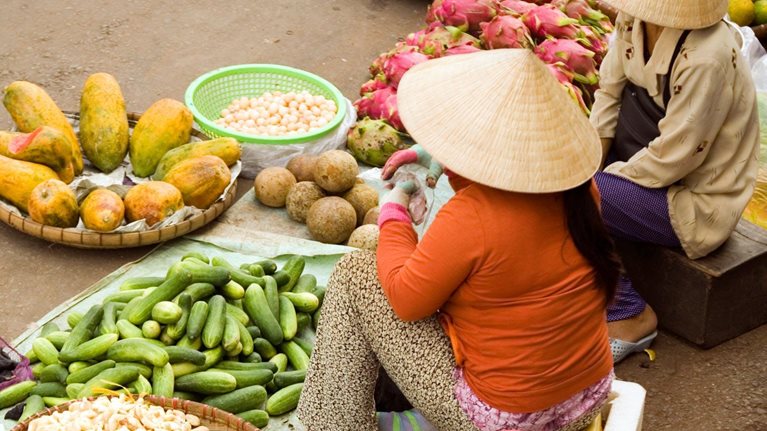Asian emerging economies are growing two to three times faster than advanced economies, attracting companies of all kinds, from automakers to insurers. The prospects in Vietnam look especially bright. Wealth, urbanization, and sophistication are rising quickly among the nation’s more than 93 million people, driving real GDP growth of about 6 percent in 2017.
Stay current on your favorite topics
Modern trade ranks among the most promising industries, as the market has yet to bloom: traditional grocers still dominate, but millions of consumers with more disposable income, less time for shopping, and new concerns about food safety will increasingly turn to modern formats. Infrastructure improvements are making stores more accessible, smaller households mean more shopping trips, and demand is growing for high-quality imported goods. Retail spending per capita is still low, and GDP per capita projections show that modern trade will take share from traditional trade as people migrate from the countryside to urban areas (Exhibit 1).

The industry is therefore likely to grow faster than GDP per capita in the coming years as young, urban, and affluent shoppers swell the ranks of the emerging middle class. Indeed, the overall grocery market has grown at more than 15 percent annually since 2012 (Exhibit 2), and most observers expect double-digit growth to continue.

Exploiting this opportunity has proven difficult so far, however. Foreign players have dived in, yet their mixed record testifies to the challenge of finding profitable growth. European grocer Casino made its first forays into Vietnam in 2003 via Big C, followed by Auchan, another European company, while South Korean Lotte entered in 2007. Since then, Casino has divested, and the other foreign players’ store expansions have slowed significantly.
Six major players now operate about 250 large supermarkets and hypermarkets among the approximately 2,000 modern retail points of sale in the country. Despite the intense competition, aggressive new players have arrived or accelerated in the past two to three years, including VinMart—boosted by the acquisition of Ocean Mart—and AEON, Asia’s largest retailer. They have gained share at the expense of the two incumbent competitors, Co.opmart and Big C.
Would you like to learn more about our Retail Practice?
We believe growth will vary widely by region and format but will remain primarily urban. Despite highly publicized plans, major players have made few investments beyond top cities; about 240 of the country’s roughly 300 large supermarkets and hypermarkets are concentrated in greater Hanoi, greater Ho Chi Minh City, the Mekong Delta, and the Red River Delta. As top urban areas get saturated, we expect big players to look for expansion opportunities further from major cities in densely populated areas, such as in Can Tho and Hai Phong, or in tier-two areas, such as Da Nang, Hue, Khanh Hoa, and Da Lat.
Strong competitors jostle for position
As recently as five years ago, Co.opmart and Big C captured three-quarters of supermarket and hypermarket business in Vietnam. Since then, however, new entrants have chipped away at their share, shrinking it to about 60 percent (Exhibit 3).

According to “mystery shopper” surveys, perceptions of the grocers vary widely, reflecting the big players’ range of strategies. Overall, the following three models emerge:
- So far, the low-price model has dominated. Some incumbents such as Big C and Co.opmart attract shoppers with a promise of low prices and a wide assortment aligned with their refill needs. Most of these stores have atmospheres designed to be familiar to consumers accustomed to traditional “wet markets.”
- The premium space is attracting new investments, mostly from foreign players. Major grocer AEON has entered the marketplace with well-designed stores, professional service, and high-quality products, such as prized Japanese goods. A fragmented group of niche players (such as Annam Gourmet Market and BioGarten) are also investing in this segment with high-end urban offerings. In those stores, shoppers seem to accept that the superior experience and assortments come with higher prices, but the model does not seem scalable beyond few shopping centers designed for wealthy consumers.
- A newcomer, Vinmart, is trying a “winner take all” expansion approach, quickly building a wide network with acquisitions and rapid opening of new stores by building on years of real-estate experience. It is supporting an “affordable, fresh quality” value proposition by vertical integration in fresh food and its private label. This approach may presage the intensification and diversification of mid-market competition.
So far, growth and intense competition seem to have come at the expense of profitability, as seen in the following examples:
- Both outside-in interviews and in-market observations point to low gross margins, driven by the necessity to compete against wet markets, intense competition between players on promotions, and supply challenges for fresh items.
- Productivity is low by Asian standards. Across the industry, stores generate only about $2,500 in sales per square meter, far less than in the Philippines or Thailand (Exhibit 4). Retailers have focused so far on expansion, hustling to gain share by opening stores early in good locations, often at the expense of productivity.

What’s the best recipe to beat wet markets?
Modern grocers face many challenges in Vietnam, including rising real-estate costs, a centuries-old tradition of buying fresh food in open-air markets, and a fragmented and shifting supplier base. Since disposable incomes are likely to rise fastest among young people in urban areas who may not own cars, the old European and North American recipes for modern retail success (in particular, the hypermarket model) will not apply.1
As major players refine their business models and build reputations with Vietnamese consumers, which will outperform?
Based on our experience around the world and our research in Vietnam, we believe the winning grocers in emerging markets will be those perceived as offering enough convenience and value for money to compete with wet markets—and those who rigorously manage resources and margins.

Modern grocery and the emerging-market consumer: A complicated courtship
This winning formula will require distinctive performance on six dimensions:
- A clear value proposition that works economically. We expect players to fail if they try to excel in every dimension—price, assortment, experience, service, and convenience. The winners will offer a focused value proposition and have a clear plan to recruit consumers from wet markets and competitors to drive traffic and basket size.
-
Rigorous productivity management to maintain 20 to 30 percent gross margins. Attaining this goal will include the following features:
- The winners will maintain consistent pricing and value proposition while protecting margins. Nearly all modern trade players in Vietnam focus on value for money. But faced with strong and cheap competition from traditional trade, many retailers charge rock-bottom prices and offer large promotional discounts, including generous loyalty programs. To compete and remain profitable, retailers need discipline in managing margins across categories, improving promotion return on investment (ROI), and tailoring membership benefits, while communicating their value proposition consistently.
- Holistic save-to-invest programs will cover sourcing, operations, pricing, and promotional investments to provide the healthy margins required for investment and expansion.
- Championing quality where it matters most. Modern grocers should manage categories to enhance the perception that they are better than wet markets for basic fresh items both on assortment breadth (for example, the availability of Vietnamese herbs or Da Lat vegetables) and on quality for highly visible items such as beef, crab, and tomatoes. This is especially important in Vietnam, where many shoppers feel uncertain about food quality and origins. In the long run, to beat fresh markets on prices, retailers will need to drive superior quality and stable sourcing along the value chain on the most important items.
- Investments in data and analytics to improve pricing effectiveness, promotional ROI, space management, and personalization as well as drive down costs. As Vietnam is not yet a sophisticated, data-driven modern retail scene, the first players to deploy advanced analytics will reap significant competitive advantages, including wiser resource allocation.
-
Careful management of size per store and footprint expansion. The following actions will boost returns on capital and avoid a downward spiral in the race for space:
- Build a dense network of smaller stores, accessible without a car and tailored for medium-size baskets. This is vitally important given the low productivity of stores in Vietnam and rising rents. Leading players are succeeding with this approach by building relatively small stores in urban areas.
- Expand to create a high-performing and consistent format tailored to the developing market. For supermarkets, for example, this will mean mid-size stores tailored to urban locations, with high visibility for categories prized by wet-market shoppers, including fresh vegetables, meat, and fish, and a consistent visual identity.
- Preparing for more intense competition. In the years ahead, new pure-food, non-food, or food-service players will disrupt the market with online-to-offline propositions, raising the bar for store economics and capabilities. Now is still the time for established players to build a reliable and flexible food ecosystem, including e-commerce, for Vietnam.
For most retailers, mastering this equation is a multiyear journey that will require a shift in focus from network expansion in saturated urban areas to targeted programs aimed at improving productivity and profitability.


